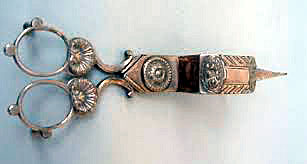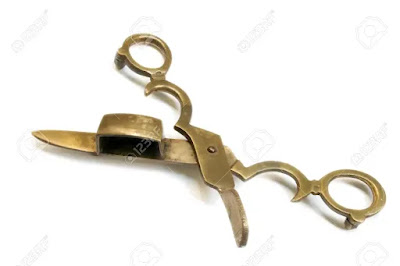 QUESTION: My grandmother loved to sew. She made her own clothes and some of those of her family. Over the years, she assembled quite a collection of sewing items. Some of the most interesting were the old sewing kits and baskets from the 19th and early 20th century. One thing I inherited from my grandmother was her love of sewing. I, too, love to sew. After she died, I got her collection of sewing items. I have no idea about the sewing kits and would like to learn more about them so that I can date them. Can you help me?
QUESTION: My grandmother loved to sew. She made her own clothes and some of those of her family. Over the years, she assembled quite a collection of sewing items. Some of the most interesting were the old sewing kits and baskets from the 19th and early 20th century. One thing I inherited from my grandmother was her love of sewing. I, too, love to sew. After she died, I got her collection of sewing items. I have no idea about the sewing kits and would like to learn more about them so that I can date them. Can you help me?
ANSWER: Before the introduction of mass-produced clothing, sewing was a way of life for every household. Usually, it was the women who took care of the making and mending of clothing. Your girls, required to master complicated sewing skills, used a variety of containers to hold their sewing tools.
 The earliest sewing containers consisted of simple bags made of fabric or leather. But by the 18th century in Europe, metalworkers, jewelers, and other craftspeople had begun making fine sewing tools for ladies of the court who also required handsome boxes to hold them. Artisans used rare woods, leather, ivory, or precious metals inlaid with gems and mother of pearl on the outsides of their boxes and lined the interiors with silk or velvet. They fitted larger boxes with two or even three levels or sections.
The earliest sewing containers consisted of simple bags made of fabric or leather. But by the 18th century in Europe, metalworkers, jewelers, and other craftspeople had begun making fine sewing tools for ladies of the court who also required handsome boxes to hold them. Artisans used rare woods, leather, ivory, or precious metals inlaid with gems and mother of pearl on the outsides of their boxes and lined the interiors with silk or velvet. They fitted larger boxes with two or even three levels or sections.
By the dawn of the Industrial Revolution, the rise of the middle class created a market for less expensive and more practical sewing boxes that were both attractive and durable. Inside, they tightly wrapped tools and notions made of steel, such as needles, pins, scissors, bodkins, buttons, hooks, and eyes to prevent them from rusting. They also used brown paper to protect delicate, colored threads from light and air, while shielding sewing silks from the elements by soft, washed leather.
 A typical Victorian sewing box would be just big enough to keep all of a woman’s sewing tools, as well as a little bit of her handiwork. Inside, you’d find a needle book with a large range of sizes, along with an assortment of thread made of cotton, linen, and silk, plus buttons formed from shells, acorns, wood, and metal. Sewing implements included different types of shears and scissors, a pin cushion and needle emery, a jar of beeswax, and a folding measure or measuring tape. Some boxes even housed tools to make lace or square cords.
A typical Victorian sewing box would be just big enough to keep all of a woman’s sewing tools, as well as a little bit of her handiwork. Inside, you’d find a needle book with a large range of sizes, along with an assortment of thread made of cotton, linen, and silk, plus buttons formed from shells, acorns, wood, and metal. Sewing implements included different types of shears and scissors, a pin cushion and needle emery, a jar of beeswax, and a folding measure or measuring tape. Some boxes even housed tools to make lace or square cords.
Victorian women considered their sewing boxes to be private—for their eyes only. Many of these boxes had locks, and ladies often kept love tokens, such as a romantic letter, a book of poetry, or an image of her beloved inside it.
 Small sewing boxes known as étui in France and "lady’s companions" in England and Germany became very popular. These portable containers usually held basic tools---scissors, needles bodkin, and a thimble—required for sewing on a day trip or for a sewing circle:. Larger lady’s companions often held a small mirror, a tiny perfume bottle, a little New Testament, a lady’s knife, tweezers, or a button hook. Some containers took the shape of books with “Lady’s Companion” printed on the spine, while others resembled fold-up leather pocketbooks. Other whimsical sewing boxes had shapes like hearts, eggs, and flasks.
Small sewing boxes known as étui in France and "lady’s companions" in England and Germany became very popular. These portable containers usually held basic tools---scissors, needles bodkin, and a thimble—required for sewing on a day trip or for a sewing circle:. Larger lady’s companions often held a small mirror, a tiny perfume bottle, a little New Testament, a lady’s knife, tweezers, or a button hook. Some containers took the shape of books with “Lady’s Companion” printed on the spine, while others resembled fold-up leather pocketbooks. Other whimsical sewing boxes had shapes like hearts, eggs, and flasks.
With the introduction of the first sewing machines in 1860, ladies discovered that their thread was too stiff to run through the new invention. As a result, George Clark introduced a six-cord, soft cotton thread for these machines in 1864, and branded it as Clark’s O.N.T. (for “Our New Thread’). In the late 19th century, the Clark Thread Company issued many sewing kits and boxes advertising this brand.
 Small, lidded baskets—woven from cane, grass, rushes, willow, honeysuckle, or bamboo—also made suitable sewing containers. In 19th-century China, a bride would be presented small gifts in ornate baskets during her wedding. These baskets were exported by the thousands to the United States starting around 1880, and were popular as sewing baskets until around 1930.
Small, lidded baskets—woven from cane, grass, rushes, willow, honeysuckle, or bamboo—also made suitable sewing containers. In 19th-century China, a bride would be presented small gifts in ornate baskets during her wedding. These baskets were exported by the thousands to the United States starting around 1880, and were popular as sewing baskets until around 1930.
By the beginning of the 20th century, baskets had become the most common sewing containers in America. Often manufacturers lined them and created spaces for a pin cushion, scissors sheath, and thimble holder sewn into the lining. Starting around 1930, wicker bucket totes became sewing containers for many women. These usually had cord handles and decal images of flowers, poodles, and sewing tools on their wooden lids.
Besides the more elaborate sewing boxes and baskets, many women created their own mending kits to hold all the necessary implements to sew or repair anything, anywhere. These mending kits also functioned as travel kits that people could easily pack and take with them.
 During the 18th century, women made mending kits called “housewifes” or “hussifs” from scraps of velvet, burlap, or leather by rolling them into a pouch with compartments for tools. They also came in other forms like purses or satchels. Wealthier women purchased kits made of ivory, wood, or silver at finer stores. Mending kits included a small pair of scissors, one or more thimbles, a needle case, spools of thread, bodkins, stilettos, clamps, buttons, and pleat makers.
During the 18th century, women made mending kits called “housewifes” or “hussifs” from scraps of velvet, burlap, or leather by rolling them into a pouch with compartments for tools. They also came in other forms like purses or satchels. Wealthier women purchased kits made of ivory, wood, or silver at finer stores. Mending kits included a small pair of scissors, one or more thimbles, a needle case, spools of thread, bodkins, stilettos, clamps, buttons, and pleat makers.
 During the first half of the 20th century, women often upcycled their old clothes into the season’s latest fashions by shortening skirts or changing hat trim. They completed this intricate work by hand, using tools found in their mending kits. Because these kits were small, ladies could take them everywhere.
During the first half of the 20th century, women often upcycled their old clothes into the season’s latest fashions by shortening skirts or changing hat trim. They completed this intricate work by hand, using tools found in their mending kits. Because these kits were small, ladies could take them everywhere.
To read more articles on antiques, please visit the Antiques Articles section of my Web site. And to stay up to the minute on antiques and collectibles, please join the over 30,000 readers by following my free online magazine, #TheAntiquesAlmanac. Learn more about "Coffee--The Brew of Life" in the 2023 Summer Edition, online now. And to read daily posts about unique objects from the past and their histories, like the #Antiques and More Collection on Facebook.


















